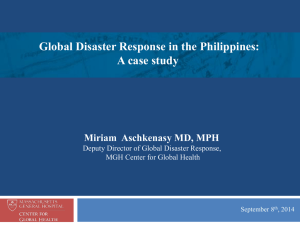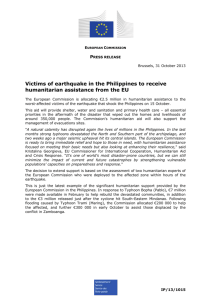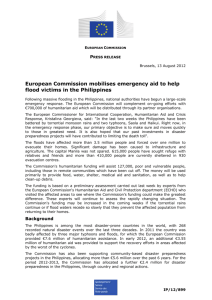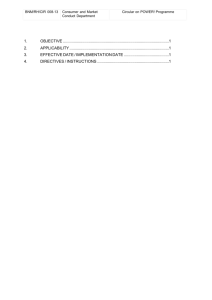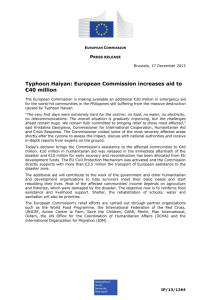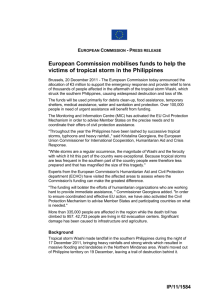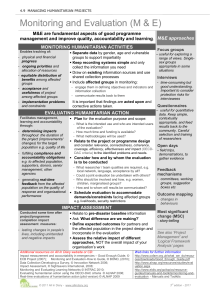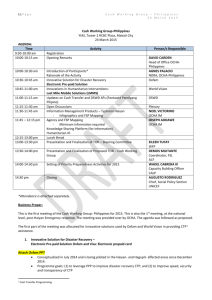Cash Working Group (CWG) Meeting
advertisement
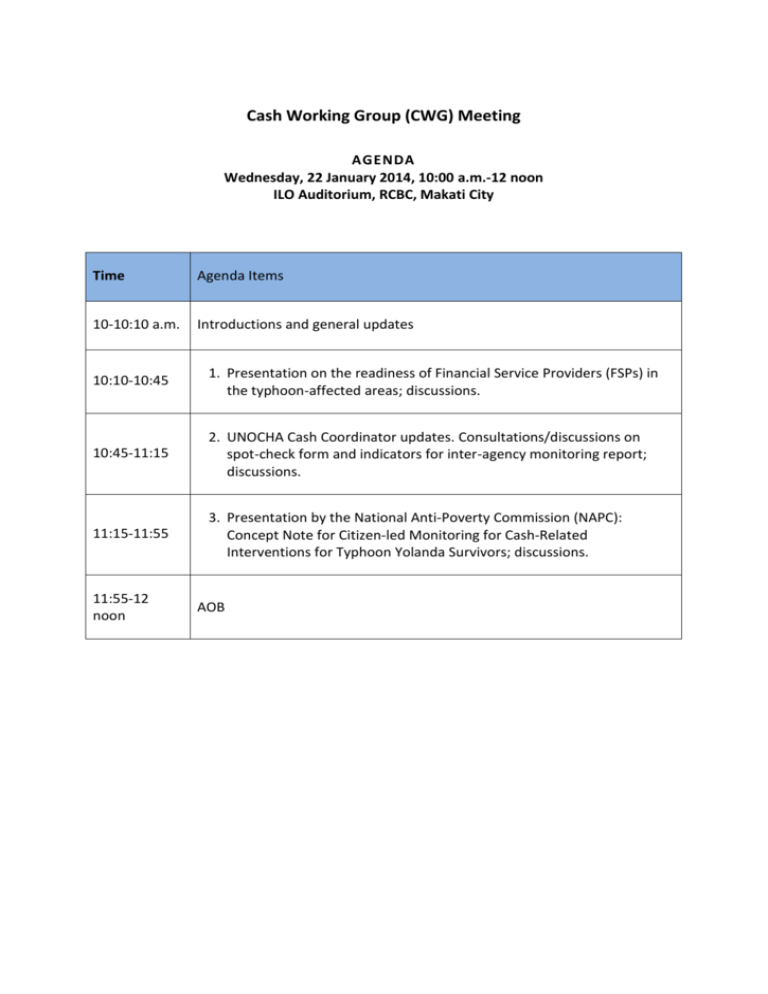
Cash Working Group (CWG) Meeting AGENDA Wednesday, 22 January 2014, 10:00 a.m.-12 noon ILO Auditorium, RCBC, Makati City Time Agenda Items 10-10:10 a.m. Introductions and general updates 10:10-10:45 1. Presentation on the readiness of Financial Service Providers (FSPs) in the typhoon-affected areas; discussions. 10:45-11:15 2. UNOCHA Cash Coordinator updates. Consultations/discussions on spot-check form and indicators for inter-agency monitoring report; discussions. 11:15-11:55 3. Presentation by the National Anti-Poverty Commission (NAPC): Concept Note for Citizen-led Monitoring for Cash-Related Interventions for Typhoon Yolanda Survivors; discussions. 11:55-12 noon AOB MINUTES Cash Working Group (CWG) Wednesday, 22 January 2014 Attendance UNOCHA, USAID-Scaling Innovations in Mobile Money (SIMM), CARE Philippines, GSMA, Philippine Red Cross (PRC), GOAL, ChildFund, Food for the Hungry, National Anti-Poverty Commission (NAPC), Food Security and Agriculture Cluster-WFP, Shelter Cluster Philippines, BPI-Globe BanKO 1. Readiness of Financial Services Providers (FSPs) and guidance to humanitarian agencies on how to approach FSPs The Scaling Innovations in Mobile Money (SIMM) project of USAID, the current chair of the Cash Working Group (CWG), has been exploring the possibility of creating a system by which humanitarian agencies can easily tap the myriad of FSPs capable of delivering cash at scale in the typhoon affected areas. It’s been recognized that the Philippines overall has a wide array of FSPs with established infrastructures nationwide and that have long been the conduits for remittances from in-country and from abroad. But they too were not spared by the devastation of Typhoon Haiyan/Yolanda. Thus, there is a need for a system of tracking the real-time readiness of FSPs in the affected areas, and a streamlined process for humanitarian agencies to engage them. The CWG Chair shared the following: Cash Pay-Out Outlets. The matrix listing cash pay-out outlets for BanKO, LBC and Cebuana Lhuillier in the Haiyan affected areas, including the priority areas in Eastern Samar, plus a map locating where these outlets are, along with functioning ATMs. Outlet locations and coverage of other FSPs will be incorporated in the list as soon as information is submitted to CWG. https://philippines.humanitarianresponse.info/document/financial-service-providerslist-outlets https://mapsengine.google.com/map/viewer?mid=zs_H893eRKo0.kTHWddX3Sr50 FSPs Overview. An overview featuring some of the major FSPs of the country and the percentage of municipalities (out of the 171 affected by Typhoon Haiyan/Yolanda) where they’ve re-established their presence. The overview also includes the number of Points-ofPresence per 10,000 affected households for each FSP. This brief overview is designed to capture some of the key points that humanitarian/aid agencies need to determine when planning their CTP and determining the most appropriate cash transfer methods; and in selecting FSPs to partner with. https://philippines.humanitarianresponse.info/document/fsps-points-presence-overview The CWG Chair stressed that the collection of these listings is a work in progress and that this initial document does not represent a complete picture. FSPs are strongly encouraged to report their readiness in the affected regions to the Chair: mamerto_tangonan@dai.com so updated versions of the matrices and map can be shared with the CWG members on a rolling basis. FSPs reporting their capacities are also encouraged to fill in the template with the maximum capacity of their outlets to accommodate bigger payout values. This is key information that, if incorporated in the template, helps inform the decisions humanitarian agencies need to make for their CTP, especially those considering medium- to large-scale cash programmes. The Chair also shared the following: FSP Inquiry Form that humanitarian agencies can use as the initial point of contact with an FSP. https://philippines.humanitarianresponse.info/document/template-fsp-inquiry-ctp FSP Engagement Process: a flowchart illustrating the basic steps/process for humanitarian agencies to engage FSPs. https://philippines.humanitarianresponse.info/document/fsp-engagement-process-ctp In the discussions, BPI-Globe BanKO announced that it is partnering with well-known pawnshop chains in the Visayas, including Tambunting, which is looking to put up roving outlets for cash disbursements. In the context of the Philippines, it was discussed that leading pawnshop franchises are a distribution mechanism that could be considered for large-scale cash interventions. Action Point 1: The CWG Chair, USAID-SIMM will step up its efforts to reach out to FSPs to submit their readiness status, and to complete the key information in the templates that would save humanitarian agencies a few steps in the engagement process. 2. Cash Coordinator Updates The new Cash Coordinator introduced herself and shared updates on some of the action points from the previous meeting. Discussions followed around a few issues that needed clarification: 2.1 Targeting beneficiaries DAFAC Cards. On targeting beneficiaries, it was reported that LGUs seem keen nowadays on humanitarian agencies using the Disaster Assistance Family Access Card (DAFAC) when targeting beneficiaries. DAFAC is designed by DSWD and issued by LGUs to families who are victims of a disaster and are therefore entitled to relief assistance from the government. The card logs assistance received by each family from the government, and if used widely and consistently by humanitarian agencies, could help prevent duplication. Confusion continues to linger around the DAFAC. There is concern that if aid is given only to those in possession of the card, some disaster-affected families may be left out. Families in possession of the DAFAC are those who were registered in evacuation centres in the early days, as well as those listed in their barangays. However, there is no clear guidance on how to target/assist displaced families, who have lost their homes and have moved to other places to live with friends and relatives. Name-matching. There was a question on the turnaround time of the name-matching verification tool being offered by DSWD’s Listahanan, or the National Household Targeting Office for Poverty Reduction (NHTO-PR). It was clarified that according to the NHTO, their system is capable of processing daily up to 14,000 names with a turnaround time of 24 hours; larger volumes of names will take longer. The Government is encouraging humanitarian agencies to use its simple name-matching sheet as this is another viable, mutually beneficial tool for coordination. NHTO will be assisting agencies verify potential beneficiaries’ profiles, track which households are already receiving assistance, etc. In return, agencies using this name-matching facility will be assisting the central government in digitizing barangay/municipality-level records, bringing local government units away from hand-written record-keeping. This will also help widen the Listahanan database, which will facilitate DSWD’s 2014 mandate to increase the 4Ps coverage by 20,000 more chronically poor households. DSWD-NHTO Template for Name Matching Form https://philippines.humanitarianresponse.info/document/dswd-nhto-template-name-matching Action Point 2.1: The UNOCHA Cash Coordinator will seek clear guidance from DSWD on targeting displaced families without DAFAC cards. The Cash Coordinator will also include discussions on targeting beneficiaries in cluster-led meetings that will be held in the hubs in the coming weeks to clarify any additional areas of confusion and to aim for a more coordinated position. 2.2 Monitoring Post-Distribution Monitoring (PDM) of Unconditional Cash Transfer: Spot-Check Form. The latest iteration of this monitoring tool was presented to the CWG. It was explained that in past CWG meetings, members endorsed UNOCHA’s efforts to explore the development of a standard monitoring tool that is shared by humanitarian agencies, and that incorporates some of the questions from the Government's Spot Check. This would be an efficient way to compare and share results for wider monitoring and lessons capture during this and future response. If enough agencies begin to use the tool, simple indicators could be captured and fed into the Inter-Agency Periodic Monitoring Report, the first one due for release end of January. The version presented to the CWG earlier borrows from IFRC’s and Oxfam’s toolkits, which have already been used in this response for large-scale CTP. Both organizations are expected to share the results to feed into the initial Inter-Agency Monitoring Report. Indicators for the first Haiyan/Yolanda response Inter-Agency Monitoring Report on the Typhoon The CWG was presented the proposed cash indicators for the draft Haiyan monitoring framework: (i) percentage of cash-for-work activities complying with minimum wage set by the Government; and (ii) percentage of cash for work activities complying with minimum wage set by the Government. The overall feedback was that the indicators were more compliance-oriented. Action Point 2.2: The UNOCHA Cash Coordinator will collaborate with DSWD’s technical team in refining/finalizing and piloting the PDM, ensuring that the English phrasing/wording can be easily translated in simple, universal Tagalog. The Cash Coordinator will also advocate for the use of the tool as an efficient way to compare and share results for wider monitoring and lessons capture during this and future response. 3. NAPC Presentation The National Anti-Poverty Commission (NAPC, represented by Undersecretary Florencia Dorotan and Technical Consultant Jay Carrizo, presented to the CWG its capability to offer Citizen-Led Monitoring for Cash-Related Interventions in the Haiyan/Yolanda response. NAPC is the Government of the Philippine’s chief agency for poverty reduction, created by the Executive branch of the government with advisory and oversight powers to formulate and implement social reform and poverty reduction programmes. It is mandated to institutionalize basic sector representation and participation in the government’s poverty reduction programmes and as such, has direct links a cross-section of government agencies in charge of fisherfolk, farmers, women, youth, children, indigenous peoples, senior citizens, cooperatives, NGOs among others. Citizen-led monitoring empowers citizens to become active partners in governance, engaging them to ensure that projects are implemented properly and services are received by the target recipients. NAPC also talked about its technologydriven Rapid Community-Based Monitoring System (Rapid CBMS) that can be employed by humanitarian agencies conducting spot checks to monitor how beneficiaries utilize cash grants. CWG members welcomed the idea of third-party monitoring. The one concern was the question of who would have ownership of the data. NAPC said that this can be specified in the Memorandum of Agreement. NAPC was invited to present in the next FSAC meeting. Humanitarian agencies interested in engaging with NAPC may contact: NAPC Undersecretary Florencia Dorotan: oyendorotan@gmail.com Technical Consultant Jay Carizo: jacarizo@gmail.com NAPC PowerPoint Presentation: Citizen-Led Monitoring for Cash-Related Interventions in the Haiyan/Yolanda Response https://philippines.humanitarianresponse.info/document/napc-citizen-led-monitoring-yolanda-cashinterventions Action Point 3: The UNOCHA Cash Coordinator will continue facilitating connections between NAPC and relevant clusters and partner humanitarian agencies and see how NAPC can play a role in providing independent, community-led checks-and-balances systems in both the process of targeting beneficiaries and monitoring cash utilization and impact post distribution.
